HIEROGONOMETRY, THE MATH OF HIEROGONS
translated by Razilee Purdue
C1978-2003 Hierogamous Enterprises
Hierogons are those Robinson polygons dissectable simplically into triangles with sides in the divine proportion, phi, f, but not Penrose darts or kites (concave and convex golden deltoids respectively). As such they symbolizes geometrically other hierogamies or "holy unions", opposites united to a higher synergistic purpose. "See now all the works of the Most High: they come in pairs, the one the opposite of the other." (Sirach 33:15) Examples would be: the male and female in procreation, space and time in Creation, God and man in the Incarnation.
These two triangles, the Golden Triangle or half-kite and its complimentary triangle, the half-dart, what we call the Antigolden Triangle, are the two of the four Robinson prototiles not also Penrose prototiles.
The golden triangle has angles in a 2:2:1 ratio: 72 degrees, 72 degrees, and 36 degrees or 2p/5, 2p/5, and p/5 radians. The other has them in a 3:1:1 ratio; 108 degrees, 36 degrees, and 36 degrees or 3p/5, p/5, and p/5 radians.
In our notation, these are simply g and a.
g' a'
g g" a
g" a  a"
a"
 g" a
g" a  a"
a" g a
Phi, f, has the unique property that G(2, 3, f) = G(2, 2, f) + f, where f = (G(2, 1/2, 5) + 1)/2 = 1.61803398875 . . . The perimeter of g is therefore f + f + 1 = f + G(2, 2, f) = G(2, 3, f) = G(2, 1/2, 5) + 2. Similarly a's is f + 1 + 1 = G(2, 2, f) + 1 = G(2, 1/2, 5) + 2. By normalizing their areas with units of G(2, 2, 3 - f)/4 they too can be designated as A'(g) = f and A'(a) = 1.
If we label the angles of the a and g as in Figure 1, with the letter for the triangle unprimed for the left base angle, singly primed for the apex angle and doubly primed for the right base angle, we can label the polygons formed from them by listing them widdershins (what used to be called before digital clocks "counterclockwise"), as in the more general Schläfli notation, but much more simply.
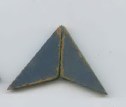
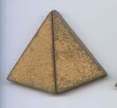
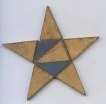


dart kite star rhombs
The dart would then be aa" (prefered to the slightly longer, but equally valid, esignation, a'a'). Similarly the kite would be gg"; g is the exact shape of one point" on a regular five-pointed star, half of not only a Penrose kite but also the long Penrose rhomb, g"g. The a is half of the short Penrose rhomb, a"a and also of the simplest tetragonal Penrose tile (a'a'gg", again designatimg angles widdershins around the central vertex, but further abbreviating to 2a'g"g.)

The classical Athenian architect Phidias, from whose initial phi gets its name, used the divine proportion in the floor plan and facades of the Parthenon. The folded pentagon or pentagram, with its many divine proportions, was the badge of the Society of Pythagoras and health. Renaissance artists used phi for their ideal proportions (total height : navel level : neck level : eye level::1:1/G(2, 2, f): 1/G(2, 4, f):1/G(2, 6, f); forearm:palm:: 1:1/f. The major sixth, c':e, 512 hz:320 hz, is near f (to 1%). Pi is nearly 6G(2, 2, f)/5 (to four decimal places); the "pyramidal pi" = 4/G(2, 2, f) (to three). The ratio of Earth's year to Venus' is f (to 0.5%). As a continuing fraction f = 1/(1 + 1/(1 + 1/(1 + . . .))), and as a continuing square root f = G(2, 1/2, G(2, 1/2, . . .(1 + (1 + (1 + . . .)))))), the simplest of both. The ubiquitous Fibonacci series: 1, 2, 3, 5, 8, 13, 21, 34 . . ., is give by: F(n) = ((G(2, n, f) - G(2, -n, f))/G(2, 1/2, 5) and found in the phyllotaxis of sunflower seeds and the nautilus shell. An element's atomic weight is approximately G(2, 2, f) times its atomic number (for Uranium's 238.03/92 to 0.6%).
The simplest Penrose tiles include, besides the 2a'g"g rhomb, three convex hexagons: the fan-like 4g' and (using a period to show a shift to vertex at the next angle counterwiddershins in the same triangle) 2g'g".gg" and gg".g2g' .



Ten others are parhexagons, that is, hexagons with pairs of parallel sides. Four are quite doubly-concave: 2a'.a"aa", 2a'.aa"a, 2a'a.a"a, a"a.a"2a'.




Two are nearly convex yet still doubly-concave:
gg"g.2g' and 2g'.g"gg".


Four are singly-concave: a1a1/ag1g1,
a1ag1g1, g1g1a1a and g1g1a/a1a1.
Two are concave pentagons with one pair of sides parallel, and ,


and two concave hexagons with two pairs of parallel sides, and


and one a symmetrical concave hexagon with two pairs of sides parallel, gg"gg".

Only four two-triangle combinations of just one g and just one a are possible sharing hierogamously one side and two vertices. They are g'a, ga, a'g and ag.




The first pair are golden trapezoids with sides in a f:1:1:1 ratio. The second pair are two larger anti-golden triangles and so can be designated as A and A respectively with the angles as before.
All four, of course, have the same areas, A* = f + 1, but their perimeters differ. The trapezoids' p = f + 3 while the larger golden triangles' p = f + 1. The sum of the inner edges, a measure complimentary to the perimeter (the sum of the outer edges), the sum of the inner edges could be called the "apometer", in analogy with the antonyms perigee (peri "around, about, enclosing") and apogee (apo "away from, off, without").
It could be broken into hierogamous, h, and non-hierogamous, a - h, parts. This would give the trapezoids' a = h = f and the larger golden triangles' a = h = 1. Similarly larger golden triangles can be formed by uniting trapezoids to a smaller one. These can be designated G and G, with angles as before.
To facilitate calculations further these numbers, N = mf + n, can be rewritten in the base half-root-five number system, thus breaking them into their irrational and rational parts, N = m(G(2, 1/2, 5) + (n + m)/2.
The perimeters above would then be represented as: the trapezoids' p = 14 and the larger anti-golden triangle's p = 34, so their perimeters are larger than the trapezoids' by 20 = 2G(2, 1/2, 5).
a h p A*
a 0 0 13 1
aa1 10 0 4 2
ag 10 10 14 12
ag1 10 10 14 12
a1a1 1 0 24 2
a1a1gg1 24 2 40 24
A 1 1 34 12
g 0 0 23 10
g1g1 10 0 24 20
G 12 12 35 23
We could also make partially hierogamous polygons, sharing only part of a side and only one vertex, not simplical or sharing a whole side and two vertices. These hiogons (not as "high" as "hier-"), are therefore not Robinson polygons. Four, 2a", 2a, g"a and ga", are miter-like concave pentagons with two parallel sides.




These shapes can made, on a larger scale, as either hiogons or hierogons.
a h p A*
aa 1 0 23 2
a1g 1 1 34 12
a1a1 1 0 23 2
g1a 1 1 34 12
a1Ag1 13 2 46 24
a1G 13 13 46 24
a1G 13 12 46 24
g1Aa 13 2 46 24
AA 13 3 46 24
AA 13 3 46 24
A1A 13 3 46 24
AA 13 2 46 24
AA 13 2 46 24
A2 13 3 46 24
G1a 13 12 46 24
G1a 13 13 46 24
The following thirty-five easily identifiable hierogons are alternatively named (using 0, 1, 2, 3, 4, 5, 6, 7, 8, 9 for half-root-five "digits" between 10 and 19, T for 20 and F for 40):

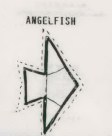
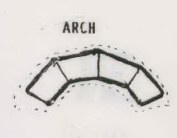
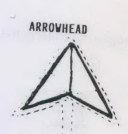

a p A*
"altar" [aroid] 11 14 12
"angelfish" [pomacanthoid] 36 59 47
"arch" [fornicoid] 43 46 44
"arrowhead" [praesagittoid] 13 46 24
"beak" [rostroid] 2 55 23
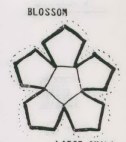
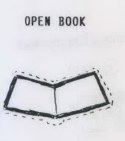
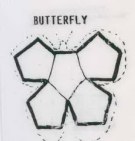
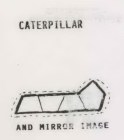
"blossum" [floroid] 27 2 68
"book" [libroid] 23 26 24
"boat" [naviculoid] 25 58 36
"bridge" [pontoid] 47 40 48
"butterfly" [papilloid] 17 18 55
"caterpillar" [erucoid] 47 40 48
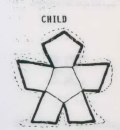
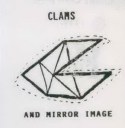
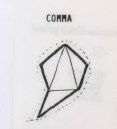
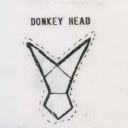
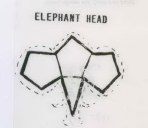
"child" [pueroid] 83 46 62
"clam" [pelecypoid] 37 70 58
"comma" [commoid] 23 16 14
"donkey head" [asinoid] 47 40 48
"elephant head" [elephantoid] 69 22 40
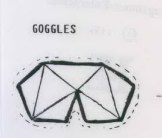
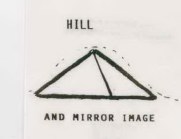
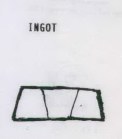
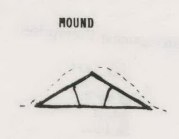
"goggles" [gogelloid] 46 19 27
"hill" [colloid] 1 34 12
"ingot" [ingotoid] 35 38 36
"mound" [tumuloid] 24 47 35
"mountain" [montoid] 12 35 23
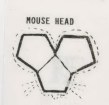
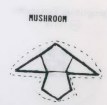

"mousehead" [muroid] 68 01 39
"mushroom" [basidiomycotoid] 47 40 48
"muzzle" [muselloid] 24 47 35
"necktie" [vinculoid] 23 26 24
"peanut" [arachoid] 45 8 26
"pentagon" 22 5 13
"rainbow" [arcoid] 59 52 50
"ring" [anuloid] 0T 0T TF
"scroll" [voluminoid] 47 40 48
"sheaf" [mergitoid] 34 17 25
"shorts" [brevitoid] 24 37 25
"sock" [calceamentoid] 57 10 38
"spearhead" [praehastoid] 25 68 46
"teepee" [tabernaculoid] 47 40 48
"valley" [valloid] 25 58 36
for more see Let Us Remember Andre Joyce